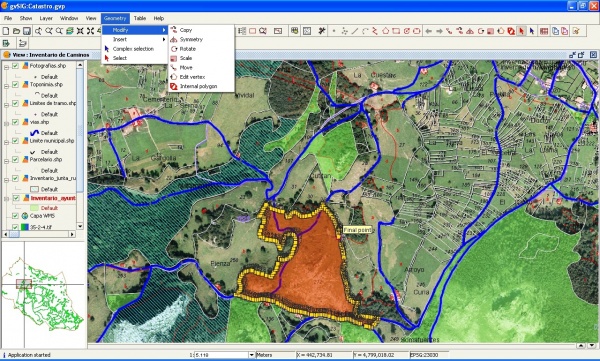If you wish to contribute or participate in the discussions about articles you are invited to contact the Editor
Mapping & GIS
| Applications | |
|---|---|
| Title | Mapping & GIS |
| Edited by | GMV |
| Level | Basic |
| Year of Publication | 2011 |
Mapping and GIS applications allow to capture, store, manipulate, analyze, manage, and present all types of geographically referenced data[1]. GIS technology combines database, mapping and statistical methods to integrate georeferenced data into visual displays where the relationships, patterns and trends in the data can be more easily identified[2].
Although Mapping and GIS applications do not rely on GNSS as sole means for data capture, the widespread of the GNSS technologies has allowed for low-cost data acquisition processes that made GIS technologies to be more generally used.
Application Architecture
Over the past decades GIS has became a multi-billion Euro industry. In parallel, the advent of satellite navigation provided a valuable tool for surveyors, hydrographers, geodesists, geophysicists and other environmental scientists in general. GIS systems are nowadays largely used not only in the science domain, but also in commercial and public service activities[3].
In Mapping and GIS, GNSS is used essentially for data capture. Traditionally data capture is one of more time consuming processes in GIS applications. GNSS has allowed low-cost automatic processes for the capture of georeferenced data.
Managers of both fixed and mobile assets and business analysts throughout the world routinely use geographical information systems (GIS). Fixed physical assets such as street furniture, power and telecom infrastructure are just some of the assets whose efficient management is facilitated by modern GIS applications. Digital map displays are routinely used in fleet management systems for vehicles of all types, relying heavily on GIS technology. Digital maps are fundamental components for in-car navigation systems[3].
The use of GNSS for data capture of georeferenced data is normally done using two main approaches:
- Surveys - One of the main ways GNSS is used for the data capture of GIS information is through surveys. Surveys are normally done with high-accuracy receivers and are usually labor intensive activities.
- Operational Georeferenced Data - The pervasive use of low-cost GNSS receivers has allowed that operational data coming from logistics systems or other business support systems is automatically georeferenced. These systems are able to generate large amounts of georeferenced data by a marginal cost. The accuracy of this data can range from meter to tens of meter level accuracies.
Application Characterization
GIS can be used in all markets across the economy. Some of the things that GIS can do are[4]:
- Map Locations - Mapping the location of things helps people to find features or patterns.
- Map Quantities - Quantities can be mapped with color codes in order to understand how they vary across the territory.
- Map Densities - Mapping densities is similar to mapping quantities but taking in account territory area.
- Map Specific Areas - Mapping what is happening in a specific area.
- Map Change - Mapping change can help to anticipate and understand future change and needs.
An example of the usefulness of mapping and GIS and how GNSS enabled the low-cost mapping of infrastructures is utility infrastructure mapping.
Utility Infrastructure Mapping
Electronic mapping systems of utility infrastructure (electrical, water, telecommunications, gas, etc) can reduce outage time by about 20% and lead to more efficient operation of the utility facilities. The precise locations of utility poles or pipes, distribution boxes and even customers can be mapped using GNSS receivers. During outages or other failures, the critical infrastructure can be identified immediately. With larger outages, maintenance crews can be dispatched to locations that will help the most customers[5].
Application Examples
Over the past decades the Mapping & GIS industry has witnessed continued growth. Some major players in the commercial market are[6][7]
- ESRI - Considered market leader. Products include ArcView and ArcGIS.
- Intergraph - Main product family is GeoMedia
- GE Energy Smallworld - GE Energy sells Smallworld Geospatial Solutions with focus on the utility market.
- MDA - MacDonald, Dettwiler and Associates - Mapping solutions.
- Bentley Systems - Products include Bentley Map and MicroStation.
- Pitney Bowes Business Insight - Products include MapInfo and MapXtreme.
- Autodesk - Products include Map 3D, Topobase, MapGuide and other products that interface with AutoCAD software package.
There are several open source initiatives with a strong support base. Some of these initiatives are[6]:
- GRASS GIS – Complete GIS originally developed by the U.S. Army Corps of Engineers.
- SAGA GIS – GIS used for editing spatial data and for the implementation of geoscientific methods.
- Quantum GIS – Multiplatform GIS.
- MapWindow GIS – Mapping application and set of programmable mapping components.
- ILWIS – GIS/Remote sensing software for both vector and raster processing.
- uDig - GIS software based on the Eclipse platform featuring a full layered Open Source GIS.
- gvSIG – Open source GIS written in Java.
- OpenJUMP – Java based vector GIS and programming framework.
Along with these initiatives, cloud-centric consumer products are being increasingly used for GIS. The most notable of these initiatives are:
While Google's and Microsoft's initiative are based in commercially licensed maps there are some initiatives of collaborative open source mapping. The most notable initiative in this area is OpenStreetMap.
Notes
References
- ^ Geographic information system in Wikipedia
- ^ What is GIS?, gis.com
- ^ What Can I Do with GIS? ESRI
- ^ Galileo Application Sheet - Energy Applications, ESA and European Commission, June 2002
- ^ a b List of geographic information systems software in Wikipedia
- ^ Daratech Press Release - GIS/Geospatial Industry Worldwide Growth Slows to 1% in 2009

